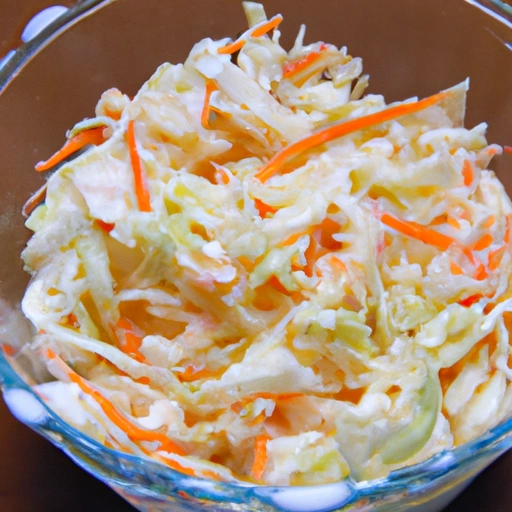Coleslaw
Description

Coleslaw is a classic salad dish primarily made from thinly sliced cabbage mixed with a variety of dressings, which can range from a simple vinaigrette to a rich, creamy mayonnaise-based dressing. Other common ingredients may include shredded carrots, onion, and additional vegetables or seasonings to enhance flavor and texture. Coleslaw can be served as a cold side dish and is known for its crunchy texture and tangy taste. It is also easily adaptable to cater to different dietary preferences and cuisines, making it a popular choice in many parts of the world.
Common uses
Coleslaw is commonly used as a side dish to complement a variety of main courses, particularly at barbecues, picnics, and potlucks. It can also be used as a topping for sandwiches, hot dogs, and burgers, adding a crunchy texture and tangy flavor. In some cuisines, coleslaw is served alongside fried foods to provide a refreshing balance.
Nutritional value
Calories
Approximately 150 calories per 100 grams (3.5 oz), though this number can vary based on dressing ingredients and additional mix-ins.
Protein
Typically around 1 gram per 100 grams (3.5 oz).
Fat
Can range from 10 to 15 grams per 100 grams (3.5 oz), largely influenced by the type of dressing used.
Carbohydrates
About 10 grams per 100 grams (3.5 oz), mostly from the vegetables.
Vitamins
Rich in vitamin K and vitamin C, with smaller amounts of vitamin A and other B vitamins depending on the additional ingredients.
Minerals
Provides a source of calcium, potassium, and magnesium.
Health benefits
Coleslaw can be a healthy addition to a balanced diet, offering dietary fiber for digestive health and a range of vitamins and minerals that contribute to overall wellness. The cabbage in coleslaw is particularly known for its antioxidant properties, which can help in reducing inflammation and boosting the immune system.
Potential risks
While coleslaw itself is made from healthy vegetables, the addition of high-fat mayonnaise-based dressings can add calories and unhealthy fats to the dish. To reduce these risks, many opt for lighter dressings, such as vinegar or yogurt-based options. It's also important to be mindful of portion sizes and the potential for sugar in some recipes.
Common recipes
Coleslaw is often found in recipes for sandwiches, tacos, and as a side for fried foods like chicken or fish. It's also a staple at outdoor events, served alongside grilled meats.
Cooking methods
No cooking is required for traditional coleslaw; it is a raw dish that's mixed and chilled. However, some variations may lightly pickle or ferment the cabbage for a different flavor profile.
Pairing with other ingredients
Coleslaw pairs well with rich and savory dishes, offering a fresh and acidic counterpoint. It's commonly paired with barbecued meats, seafood, and hearty sandwiches.
Summary
Coleslaw is a simple yet diverse salad that has transcended its Dutch origins to become a beloved side dish around the world. Its combination of crunchy cabbage, zesty dressing, and nutritional benefits make it a preferred choice for many meals. Whether served in its classic creamy style or with a lighter vinaigrette, coleslaw continues to be a versatile and flavorful addition to countless dishes.